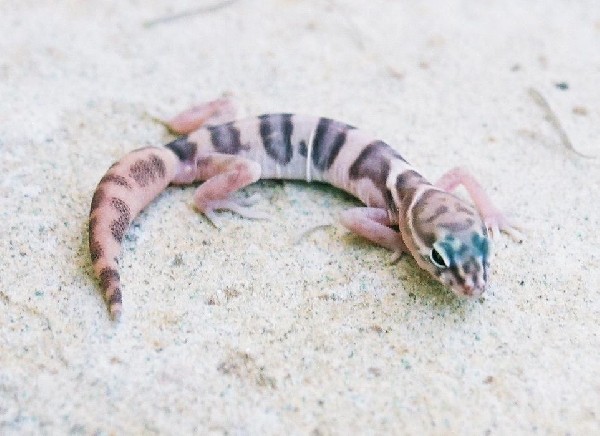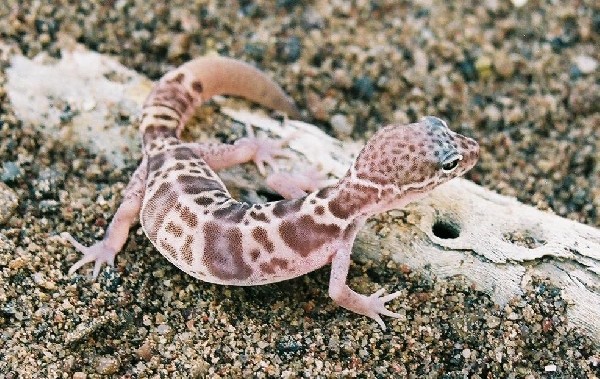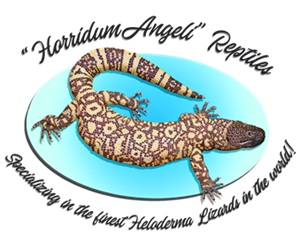 | mobile - desktop |
 |
 Contact Sales! |
News & Events:
|
by Petra Spiess  There are three subspecies of the banded gecko that occur in Arizona. The desert banded
gecko (Coleonyx variegatus variegatus), is found over most of the western half of
the state, the Tucson banded gecko (Coleonyx variegatus bogerti) is found over the
southeastern quarter of the state, and the Utah banded gecko (Coleonyx variegatus
utahensis) has a restricted range in the extreme northwestern corner of the state. All
three subspecies range in length from 2-3 inches (5-7.5 cm), posses moveable eyelids,
fine, granular scales, and vertical pupils (Stebbins, 1985). The ground color ranges from
a pink to pale yellow, with bands of brown and various amounts of brown spotting. Desert
banded geckos are associated with extremely diverse habitats such as creosote flats,
desert grasslands, and pinon-juniper belts. This species is nocturnal and terrestrial,
spending the majority of the day hidden under or in rocks, crevices or subterranean holes.
Banded geckos, like most desert reptiles, are most active in spring, when temperatures and
food availability are favorable. The best time to find these geckos therefore, is from
April to May after a rain. During the day banded geckos can be found by lifting up rocks
or debris that have large pockets of moist ground beneath them. Turning over objects made
of cardboard, or other objects which retain water, is a good way to capture desert banded
geckos. At nighttime, this species can be found crossing roads, look for their eyeshine in
the headlights. Desert banded geckos will voice their protest at being captured by letting
out a loud squeaking noise. There are three subspecies of the banded gecko that occur in Arizona. The desert banded
gecko (Coleonyx variegatus variegatus), is found over most of the western half of
the state, the Tucson banded gecko (Coleonyx variegatus bogerti) is found over the
southeastern quarter of the state, and the Utah banded gecko (Coleonyx variegatus
utahensis) has a restricted range in the extreme northwestern corner of the state. All
three subspecies range in length from 2-3 inches (5-7.5 cm), posses moveable eyelids,
fine, granular scales, and vertical pupils (Stebbins, 1985). The ground color ranges from
a pink to pale yellow, with bands of brown and various amounts of brown spotting. Desert
banded geckos are associated with extremely diverse habitats such as creosote flats,
desert grasslands, and pinon-juniper belts. This species is nocturnal and terrestrial,
spending the majority of the day hidden under or in rocks, crevices or subterranean holes.
Banded geckos, like most desert reptiles, are most active in spring, when temperatures and
food availability are favorable. The best time to find these geckos therefore, is from
April to May after a rain. During the day banded geckos can be found by lifting up rocks
or debris that have large pockets of moist ground beneath them. Turning over objects made
of cardboard, or other objects which retain water, is a good way to capture desert banded
geckos. At nighttime, this species can be found crossing roads, look for their eyeshine in
the headlights. Desert banded geckos will voice their protest at being captured by letting
out a loud squeaking noise.
Captive Care Desert banded geckos can be housed in a number of ways. Pairs of geckos can be housed in shoebox sized rack units (14 x 7 x 4 in, 35 x 17.5 x 10 cm ) , and can easily be commercially bred. Alternately, breeding groups of geckos, one male to three or more females, can be housed in enclosures with the minimum dimensions of 24 x 12 x 6 inches (60 x 30 x 15 cm) Males should not be housed together, their aggressive combating will eventually lead to the injury or death of one or both of the participants. Appropriate substrate for banded gecko housing includes playground sand, wood chips, peat moss, natural substrate, or newspaper. Although banded geckos are found primarily in dry regions, they still require a humidity spot in their enclosure where the relative humidity is 60-80% in order to properly shed their skin. As is the case with other desert reptiles, the microhabitat that these animals spend the majority of their time in has a much higher relative humidity than the surrounding areas. Humidity spots are easily create from deli cups or Tupperware. Make sure the humidity site container is large enough to house all of the geckos in the enclosure. Cut an access hole in the top or side of the container. Fill the container half way with damp peat or sphagnum moss. Always keep this area moist and replace the moss when it becomes soiled. Desert banded geckos do not bask, so the best type of heating fixture to use with this nocturnal species in an undertank heating pad or heat tape. The cool end temperature should be 75-80 degrees F (24-27 degrees C) and the warm end should be 85-88 degrees F (29-31 degrees C). Make sure to provided hiding areas on both the warm and cool ends of the enclosure, so the geckos can maintain their preferred body temperature. Gut loaded domestic crickets should form the nucleus of the captive diet. Avoid feeding insects that are much larger than the gecko's heads, insects that are too large can cause intestinal impaction. Other insects of appropriate size such as cockroaches, pill bugs, grasshoppers (small ones), and mealworms will also be eagerly accepted. Banded geckos can be fed three to four times a week. At every other feeding, they prey items should be coated with a high quality reptile calcium supplement. A small dish of calcium supplement may also be included in the enclosure itself to prevent the animals from ingesting substrate in a search for dietary calcium. A small, shallow container of clean water should be available at all times. As these geckos are nocturnal, full spectrum lighting is not necessary, although it will benefit any plants in the enclosure. Breeding Male banded geckos can be distinguished from females by the presence of small fleshy appendages on either side of the tail base. Sexual maturity is usually reached at 12 months of age, although well fed specimens may reach breeding age at 9 months. Hibernation for 3-4 weeks at 50-59 degrees F (10-15 degrees C) is recommend to cycle the adults for breeding. Breeding has occurred without this hibernation period, but seems to produce less successful results. Breeding behavior occurs after this winter hibernation period. The male uses a copulation bite during mating, and can injure the female in his ardor. Watch female geckos during the breeding season for any torn skin. Open wounds should be treated with an antiseptic ointment or liquid to prevent infection. After breeding has been noted, include an egg-laying chamber in the enclosure if a humidity site is not already present. Oviposition generally occurs from April to October, although egg-laying can occur at any time during the year. Generally, there are two eggs per clutch, and females can lay up to five clutches during the season. Incubation temperature should be 80-85 degrees F (26.6-29.4 degrees C), with the eggs resting in slightly damp vermiculite. Incubation times range from 45-60 days. The young should be housed individually, and have the same environmental needs as the adults. Banded geckos are one of Arizona's most common reptiles, the next species, the gila monster (Heloderma suspectum) is much harder to observe in the wild. 
< Green Ratsnake - Back || Next - Gila Monster > |
Sponsored Link
Recent Gecko Forum Forum Posts • R. leachianus (Leachie) Enclosure, posted by dleary946 • feeding ur leopard gecko, posted by leothegecko44 • Chahoua Eggs... Single Clutch?, posted by moc_reptiles • Not finding food, posted by survey33 • Pseudogonatodes, posted by marimo • Cyrtodactylus peguensis, posted by Patton • Hi from 1001Geckos, posted by 1001Geckos • what kind are these, posted by muggyb • Need help, posted by rodingotx • T. americana, posted by louxie • Will Geckos eat each other?, posted by jpropst1 • albino levis?, posted by geckoejon • Levis Males?, posted by scooterisaboss4 • gender identification???, posted by geckoejon • daytona 2013?, posted by geckoejon • URGENT ,gecko found, posted by rrubberbandman • Super Light Yate Leachianus, posted by Tom Keogan • Help indentifying this Gecko, posted by jburetz • House Gecko EGGS!, posted by reptilekeeper999 • Marco Island geckos, posted by reptilekeeper999 Recent Gecko Classifieds: - WANTED Geckosopen to al... New & Updated Business Listings |
.jpg)






